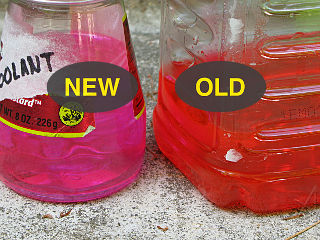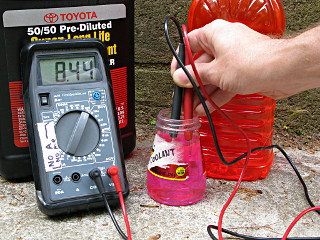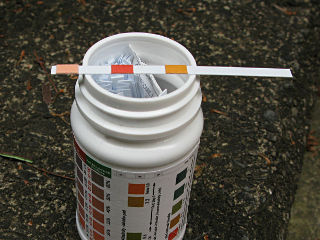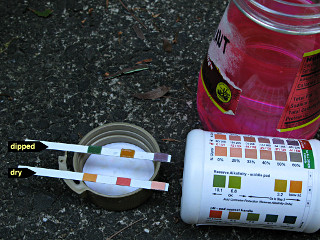
| Part 1: Overview; tires/brakes | |
| Part 2: Underhood | |
| Part 3: Headlights: the Big Schnoz | |
| Part 4: Inverter pump | |
| ==> | Part 5: Coolant testing |
| Part 5b: Engine coolant | |
| Part 6: Transaxle / driveline, references |

|
But the new coolant, if anything, is *more* conductive than the old. So
this probably isn't a valid test at all, at least not here.
There are, however, very relevant electrolytic effects that can eat right through thin metal parts such as radiator cores. Currents can be generated by the coolant fluid itself in contact with the different metals found around the engine block and radiator and heater-core, all acting like a battery; or the car's own electrical system coupled with bad grounds to engines or other parts can wind up pushing some of the return current through the coolant and literally blasting ions off internal metal surfaces. Adding secondary grounds is one mitigation strategy but doesn't always work as expected. The presence of these effects can be tested for in different ways but this isn't really the right place to get deep into it; but do see the references section for some discussion on some of the crazy things that can happen and what people have [often erroneously] tried to do about it. |
|
After this inconclusive goofing around, more research is clearly needed.
What the heck is "non-silicate, non-borate, non-amine, hybrid organic acid
technology" anyway?? Why is there so much mythology and disinformation
floating around about coolants? Well, the fact is that coolant chemistries
*and* engine/radiator metallurgy have changed rather radically in the last
decade, and the fact that a fill of coolant now has an expected 100,000 mile
or more corrosion-resisting service life is somewhat amazing in its own right.
It's definitely cut into the classic radiator flush-n-fill service upsell
that so many garage guys are used to suggesting to customers, so there are
significant forces at work to keep the coolant-change mystique alive as long
as possible, but it seems that at this stage of the game it's about as
present-day as carburetors and mechanical spark advance.
There are a few fundamental but often subtle facts that come into play, and there's much more to be found under "coolants" in the reference section.
Anything more in-depth than this quick summary, however, is beyond my own chemical savvy and the references speak to it with far more authority than I can. The perfect liquid-coolant would be one with the heat-carrying capacity of water, the liquid-phase stability of ethylene glycol, the lubricity of light oil, and otherwise be completely inert. News of such a witch's brew has *not* yet come to Hahvahd, so everything we have now is a set of workarounds. The bottom line is that although coolant formulation is often complex, these words and terms shouldn't be so mysterious, and the expected lifetimes and benefits of these different types of coolants are becoming somewhat better understood by now but usually at an "only use this stuff!" level. That's still not going to stop your corner service guy from stroking his chin and going "36,000 miles? You need new coolant" as a way to drum up a little work, and we need a second opinion. Thus, the question remains of how to more accurately test what's going on with a given chemistry in coolants of a given age. |

|
Here's one answer: more test strips.
The Acustrip company has been in the
fluid-testing biz for a number of years, not just for antifreeze but water
quality and some other areas as well. Their strips have multiple reagent
pads and measure several characteristics at once, which is useful because
the number of different coolant mixtures out there can produce quite
different results.
There's a bag of silica "do not eat" in with these, to help their shelf life. |

|
Okay, so what does *new* coolant look like? Not that different, it turns out.
Hmmmm. |